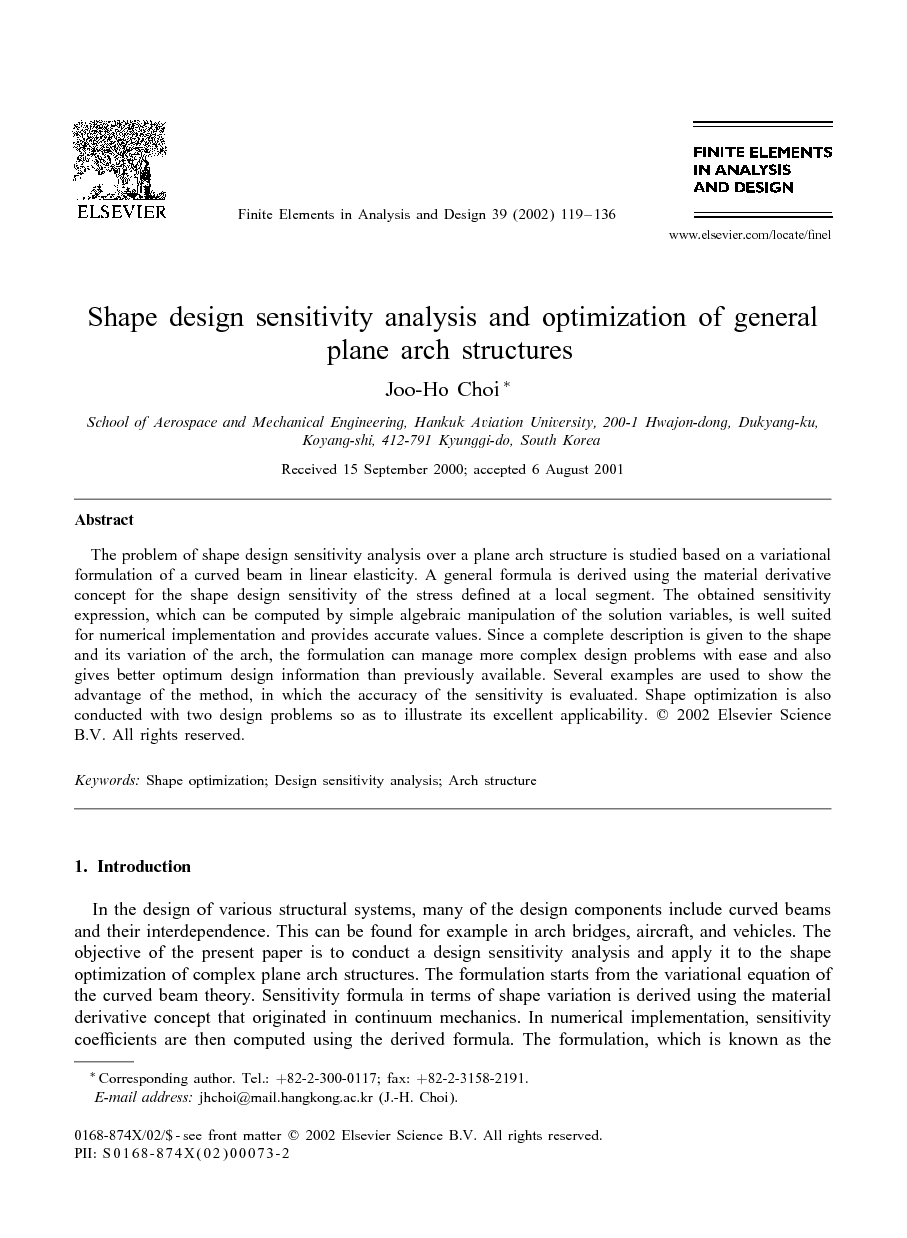The problem of shape design sensitivity analysis over a plane arch structure is studied based on a variational formulation of a curved beam in linear elasticity. A general formula is derived using the material derivative concept for the shape design sensitivity of the stress defined at a local segment. The obtained sensitivity expression, which can be computed by simple algebraic manipulation of the solution variables, is well suited for numerical implementation and provides accurate values. Since a complete description is given to the shape and its variation of the arch, the formulation can manage more complex design problems with ease and also gives better optimum design information than previously available. Several examples are used to show the advantage of the method, in which the accuracy of the sensitivity is evaluated. Shape optimization is also conducted with two design problems so as to illustrate its excellent applicability.
In the design of various structural systems, many of the design components include curved beams and their interdependence. This can be found for example in arch bridges, aircraft, and vehicles. The objective of the present paper is to conduct a design sensitivity analysis and apply it to the shape optimization of complex plane arch structures. The formulation starts from the variational equation of the curved beam theory. Sensitivity formula in terms of shape variation is derived using the material derivative concept that originated in continuum mechanics. In numerical implementation, sensitivity coefficients are then computed using the derived formula. The formulation, which is known as the continuum approach, contrasts with the finite dimensional one, where the sensitivity is obtained from the discretized equations. Plenty of research has been made in this direction by Haug and Choi [1], Dems and Mroz [2], and others for a wide class of structural and thermal problems.
In the arch shape design sensitivity, the continuum approach was first studied by Dems and Mroz [3], in which a general procedure was presented for plane arches using variational calculus, of which the concept is identical to the material derivative concept. They described arch shape by arch length parameter, and considered shape variation in general by moving in tangential as well as normal direction. The sensitivity formula, however, includes higher-order derivatives of the strain, which are not tractable since necessary numerical differentiation tends to degrade the accuracy. Dopker et al. [4], and Chenais et al. [5] presented a similar formulation in which the shape is described by an explicit equation in Cartesian coordinate, and its variation is considered in the normal direction only. Therefore, their formulation lacks generality in that the shape is limited to shallow arches and cannot be applied to the shape variation in an axial direction. Kim and Kwak [6] proposed a remedial method to handle general arch problems by subdividing the shape into segments, each of which can be considered as a shallow arch. Recently, another study was carried out by Habbal [7] for arch structures considering min–max stress problems, but which is still limited to the shallow arch.
In this paper, a general formulation is developed using the material derivative concept for the shape design sensitivity of the stress functional defined at a local segment of an arch. An adjoint variable is employed for the explicit expression of the sensitivity in terms of the general shape variation. The obtained formula is well suited for numerical implementation since the sensitivity computation requires mostly the algebraic manipulation of the strains obtained from the finite element analysis. Therefore, the formula does not lose accuracy. A description of the general arch shape and its shape variation, which can move in every direction, including tangential as well as normal directions is shown. Therefore, the formulation is not limited to the shallow arch and can manage more complex design problems, including shape variation in the axial direction, i.e., arch length variation. Several examples are made to show the advantage of the method in which the accuracy of the sensitivity is evaluated. Shape optimization is also conducted with two design problems to illustrate its excellent applicability.
The present paper addresses the shape design sensitivity analysis of a plane arch structure based on the variational formulation of a curved beam in linear elasticity. The sensitivity expression derived using the material derivative concept is very general, and can thus be applied to complex arch shapes and their variation in a general direction. Hence the application is not limited to the shallow arch and can handle complex design problems. Arch length variation can also be taken into account easily. The sensitivity expression also enables an accurate and efficient evaluation in numerical implementation since most of the computation involves simple multiplication and addition of the solution variables obtained from ANSYS. Hence it avoids numerical differentiation that happens frequently in other methods or formulations, which may be the major cause of inaccuracy. In this study, ANSYS is adopted as the analysis tool, in which only a straight line element is provided. Therefore, the sensitivity evaluation is simplified due to the zero curvature. However the formulation is not limited to the linear element but can also employ higher order elements using the derived formula. Use of ANSYS makes the procedure easy to implement since one needs only to create a code using the parametric language of ANSYS to build a model, assign design parameters, solve the problem, and post-process. From the examples of sensitivity analysis and optimization, it is verified that the proposed method can be a useful and easy tool in finding the optimum shape of a variety of arch structures.


